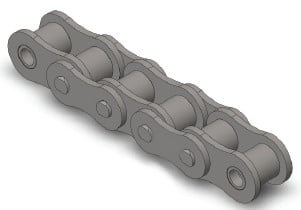Roller chains are 1 with the most productive and price eff ective ways to transmit mechanical power in between shafts. They operate over a wide range of speeds, take care of large functioning loads, have pretty compact energy losses and are usually inexpensive in contrast with other solutions
of transmitting electrical power. Productive selection entails following many relatively easy measures involving algebraic calculation along with the use of horsepower and service factor tables.
For almost any offered set of drive ailments, there are a variety of feasible chain/sprocket confi gurations which can successfully operate. The designer hence should be conscious of several fundamental selection rules that when applied the right way, assist stability all round drive efficiency and value. By following the steps outlined within this part designers must be ready to create selections that meet the necessities with the drive and are expense eff ective.
Standard Roller Chain Drive Principles
? The encouraged quantity of teeth to the modest sprocket is 15. The minimal is 9 teeth – smoother operation is obtained with far more teeth.
? The recommended maximum quantity of teeth for that big sprocket is 120. Note that whilst a lot more teeth makes it possible for for smoother operation obtaining as well lots of teeth leads to chain jumping off the sprocket after a somewhat tiny quantity of chain elongation as a consequence of put on – That is certainly chains that has a incredibly huge variety of teeth accommodate less wear ahead of the chain will no longer wrap all over them properly.
? Speed ratios must be seven:one or less (optimum) and never better
than 10:one. For bigger ratios using a number of chain 
? The advisable minimal wrap of your compact sprocket is 120°.
? The recommended center distance among shafts is 30-50 pitches of chain. You will discover two exceptions to this as follows:
one. The center distance needs to be greater compared to the sum in the outside diameters of the driver and driven sprockets to avoid interference.
two. For speed ratios greater than 3:one the center distance shouldn’t be much less compared to the outdoors diameter in the massive sprocket minus the outdoors diameter of the modest sprocket to assure a minimal 120° wrap all over the modest sprocket.